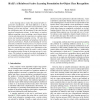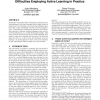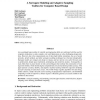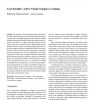145
Voted
CVPR
2012
IEEE
13 years 2 months ago
2012
IEEE
Active learning aims to reduce the amount of labels required for classification. The main difficulty is to find a good trade-off between exploration and exploitation of the lab...
174
click to vote
CVPR
2012
IEEE
13 years 5 months ago
2012
IEEE
Learning from streams of evolving and unbounded data is an important problem, for example in visual surveillance or internet scale data. For such large and evolving real-world data...
150
click to vote
ACL
2011
14 years 4 months ago
2011
We present a pointwise approach to Japanese morphological analysis (MA) that ignores structure information during learning and tagging. Despite the lack of structure, it is able t...
212
click to vote
PAKDD
2011
ACM
14 years 6 months ago
2011
ACM
Discovering rare categories and classifying new instances of them is
an important data mining issue in many fields, but fully supervised
learning of a rare class classifier is pr...
133
Voted
SIGKDD
2010
14 years 7 months ago
2010
Despite the tremendous level of adoption of machine learning techniques in real-world settings, and the large volume of research on active learning, active learning techniques hav...
128
Voted
JMLR
2010
14 years 7 months ago
2010
An exceedingly large number of scientific and engineering fields are confronted with the need for computer simulations to study complex, real world phenomena or solve challenging ...
135
click to vote
INTERSPEECH
2010
14 years 7 months ago
2010
Stochastic dependency parsers can achieve very good results when they are trained on large corpora that have been manually annotated. Active learning is a procedure that aims at r...
112
Voted
IJCV
2011
14 years 7 months ago
2011
Abstract We present an active learning framework that predicts the tradeoff between the effort and information gain associated with a candidate image annotation, thereby ranking un...
117
click to vote
COLING
2010
14 years 7 months ago
2010
This paper presents a novel semisupervised learning algorithm called Active Deep Networks (ADN), to address the semi-supervised sentiment classification problem with active learni...
113
click to vote
COLING
2010
14 years 7 months ago
2010
Active learning has been applied to different NLP tasks, with the aim of limiting the amount of time and cost for human annotation. Most studies on active learning have only simul...




